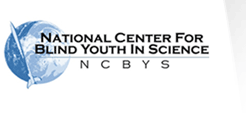Make a Gift to the NFB Jernigan Institute Contact Us Site Map
Observations on the Math Needs of College Undergraduates with Visual Disabilities
A presentation by Joan Francioni, Winona State University
Background
I am:
- Chair of a Computer Science Department
- Co-director of CSCAP - Computer Science Curriculum Accessibility Project, for the past 4 years
- Sighted
My experience with blind students who were not math majors but were taking college-level math courses during this time includes:
- Working with a group of eight students:
- Two low vision
- Six blind
- Two non-Computer Science majors
- Six Computer Science majors
- Algebra
- PreCalculus
- Discrete Math
- Calculus
General Observations
- Accessible textbooks are a huge problem.
Although it is getting easier to get electronic versions of the texts from publishers, the mathematical content is still inaccessible. Our strategies have been to get the electronic versions of the texts and then edit them by typing in the equations and generating the graphs.- This process requires knowledgeable student workers
- It is time consuming and prone to error
- We found it was extremely important, however, for the visually impaired students to have access to the full book. And audio recorded versions of the text are insufficient and, sometimes, a disadvantage.
- Strategies being used by students coming in are harmful.
We noticed that the students coming into the program were very dependent on working out math problems in their head.- This process is very susceptible to small, and sometimes large cumulative, mistakes.
- Students cannot be interrupted or distracted at all while working on a problem. If they are, they need to start again from the beginning.
- It is very difficult to 'see their work - for a problem and, hence, to give feedback on how they are approaching a problem.
- There is a limit on how big a problem most of the students can handle.
- No one on campus, other than some of our blind students, knows Nemeth code.
Our Philosophy
- Instructors and students need to be self-sufficient.
Other than some initial instruction about procedure, the students and their instructors need to be able to work through the class on their own.- We want instructors to be able to generate the notes in an accessible format, without much, if any, extra work from what they would do for their sighted students. This does imply, however, that the instructor does use electronic media for notes.
- We expect students to be able to print out whatever they need on the Tiger printer themselves.
- The department provides support for printing out tests for the instructors
To make this happen, we need to have procedures that are straightforward and easy for instructors and students, both sighted and non-sighted, to pick up.
- Instruction for the visually impaired students needs to be part of the regular class.
- This instruction includes both the subject and any tools being used for the class, e.g., programming IDEs or math problem-solving programs.
- Having students/instructors dependent on me or the Disability Resource Center to give them special instructions is inefficient, at best.
- Providing separate tutoring for the visually impaired students by either the instructor or student assistants creates a 'separate but not equal - situation.
- Laptops for the visually impaired students are a necessity.
Wish List for an Accessible Math Tool
We would like a Math software tool for our visually impaired students that has the following properties:
- Both sighted and non-sighted students should be able to use the tool to work on math problems.
- The tool should be straightforward for both students and instructors to use.
- The tool should provide a way to record the steps of a problem solution so that:
a. Students can easily back up to previous steps.
b. Students can turn in a copy of the steps of their final solution to 'show their work - .
c. Instructors can grade the solutions and give feedback to students. - The tool should provide a way for students to easily navigate the hierarchical structure of the equation. In particular, they should be able to:
a. Consider sub-expressions as an entity.
b. Collapse, expand, and substitute sub-expressions at any time. - Input: the tool should handle both real-time input and input from a file.
- Output: the tool should generate MathML representations of expressions. It should also provide reasonable defaults and customizations for screen reader pronunciations of special symbols.
- The tool must not automatically do any of the mathematics for the students. This is very important in a tool that is being used by students who are learning Math. They need to be free to make the same mistakes that sighted students make!
Joan Francioni
Computer Science Professor
Winona State University
jfrancioni@winona.edu

